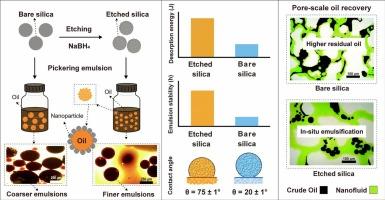Chemically surface-etched nanoparticles for tailored Pickering emulsions in enhanced oil recovery
IF 5.2
2区 化学
Q2 CHEMISTRY, PHYSICAL
引用次数: 0
Abstract
Nanoparticles are widely used in Pickering emulsions, but their hydrophilic nature often limits interfacial effectiveness. This study explores a novel chemical etching method using the strong reductant sodium borohydride (NaBH₄) to enhance the interfacial properties of silica nanoparticles, improving oil recovery through more efficient Pickering emulsification. Characterization confirms surface etching through TEM and XPS, showing a rougher surface and a hydrodynamic size of 164.43 nm for etched silica, compared to 197.74 nm for bare silica. The etched silica nanoparticles exhibit increased hydrophobicity, as evidenced by FT-IR and contact angle measurements (θ = 75 ± 1° for etched silica vs. θ = 20 ± 1° for bare silica). At 500 ppm, modified silica nanoparticles facilitate Winsor emulsions I and II, with etched silica producing smaller, more stable droplets. Increasing the concentration to 2500 ppm reduces droplet size and tightens distributions, especially with etched silica, enhancing emulsion stability due to stronger interfacial layers, non-spherical shape, and lower bending resistance, as shown by desorption energy values of ⁓ 3.91 × 10−18 J for bare silica and ⁓ 3.49 × 10−16 J for etched silica. Pore-scale experiments demonstrate that surface-etched silica nanoparticles improve oil displacement and reduce residual trapping by promoting oil-in-water emulsions, outperforming bare silica due to stronger mechanical interactions, higher negative charge, and increased disjoining pressure (−4.81 × 10−4 Pa vs −8.38 × 10−4 Pa). This innovative modification approach, previously unexplored in oil recovery, offers a new pathway for enhanced oil mobilization and emulsion stability, with potential for broader applications in wastewater treatment, catalysis, and pharmaceuticals.

化学表面蚀刻纳米颗粒,用于定制皮克林乳液,提高石油采收率
纳米颗粒广泛应用于皮克林乳液中,但其亲水性往往限制了界面的有效性。本研究探索了一种新的化学蚀刻方法,使用强还原剂硼氢化钠(NaBH₄)来增强二氧化硅纳米颗粒的界面性质,通过更有效的Pickering乳化来提高石油采收率。通过TEM和XPS表征证实了表面蚀刻,表明蚀刻二氧化硅表面更粗糙,流体动力尺寸为164.43 nm,而裸二氧化硅为197.74 nm。通过FT-IR和接触角测量(θ = 75±1°,θ = 20±1°)可以证明,蚀刻二氧化硅纳米颗粒的疏水性增强。在500ppm时,改性二氧化硅纳米颗粒促进了Winsor乳剂I和II,蚀刻二氧化硅产生更小,更稳定的液滴。当浓度增加到2500 ppm时,液滴尺寸减小,分布更紧,特别是蚀刻二氧化硅,由于界面层更强,非球形和更低的弯曲阻力,增强了乳液的稳定性,如裸二氧化硅的解吸能⁓3.91 × 10−18 J和蚀刻二氧化硅的解吸能⁓3.49 × 10−16 J所示。孔隙尺度实验表明,表面蚀蚀的二氧化硅纳米颗粒通过促进水包油乳液来提高驱油效果,减少残留捕获,优于裸二氧化硅,这是由于更强的机械相互作用、更高的负电荷和更高的分离压力(- 4.81 × 10−4 Pa vs - 8.38 × 10−4 Pa)。这种创新的改性方法以前未在采油中探索过,为提高油的动员和乳液的稳定性提供了一条新的途径,在废水处理、催化和制药方面有更广泛的应用潜力。
本文章由计算机程序翻译,如有差异,请以英文原文为准。
求助全文
约1分钟内获得全文
求助全文
来源期刊

Journal of Molecular Liquids
化学-物理:原子、分子和化学物理
CiteScore
10.30
自引率
16.70%
发文量
2597
审稿时长
78 days
期刊介绍:
The journal includes papers in the following areas:
– Simple organic liquids and mixtures
– Ionic liquids
– Surfactant solutions (including micelles and vesicles) and liquid interfaces
– Colloidal solutions and nanoparticles
– Thermotropic and lyotropic liquid crystals
– Ferrofluids
– Water, aqueous solutions and other hydrogen-bonded liquids
– Lubricants, polymer solutions and melts
– Molten metals and salts
– Phase transitions and critical phenomena in liquids and confined fluids
– Self assembly in complex liquids.– Biomolecules in solution
The emphasis is on the molecular (or microscopic) understanding of particular liquids or liquid systems, especially concerning structure, dynamics and intermolecular forces. The experimental techniques used may include:
– Conventional spectroscopy (mid-IR and far-IR, Raman, NMR, etc.)
– Non-linear optics and time resolved spectroscopy (psec, fsec, asec, ISRS, etc.)
– Light scattering (Rayleigh, Brillouin, PCS, etc.)
– Dielectric relaxation
– X-ray and neutron scattering and diffraction.
Experimental studies, computer simulations (MD or MC) and analytical theory will be considered for publication; papers just reporting experimental results that do not contribute to the understanding of the fundamentals of molecular and ionic liquids will not be accepted. Only papers of a non-routine nature and advancing the field will be considered for publication.
 求助内容:
求助内容: 应助结果提醒方式:
应助结果提醒方式:


